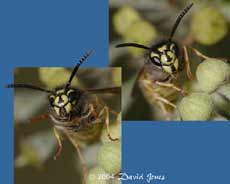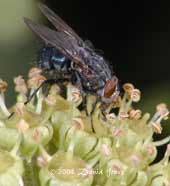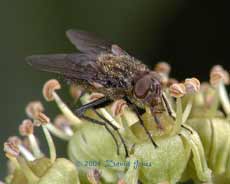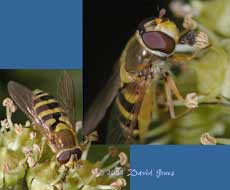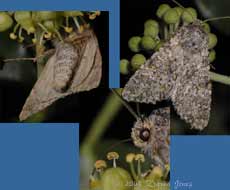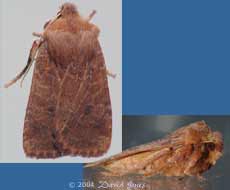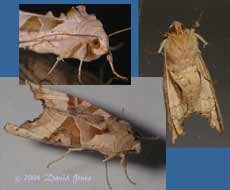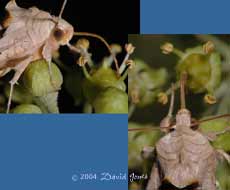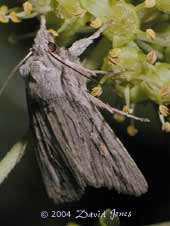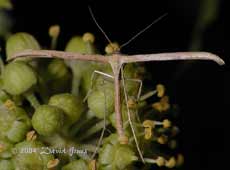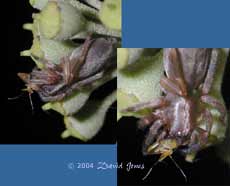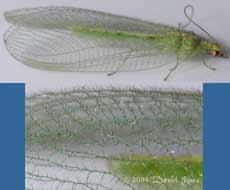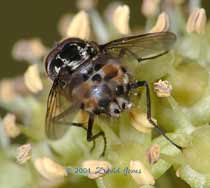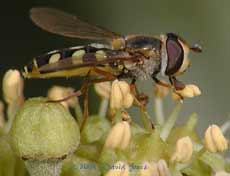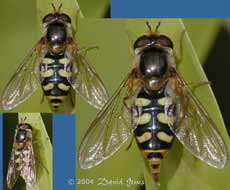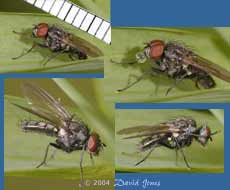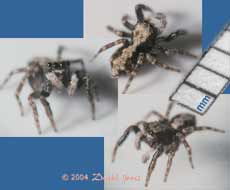Go to latest entry.....................................Go to previous entry11 October - It's a week since we got back from Cornwall and at last I'm getting down to catching up with my diary. The weather has been largely dry and the water levels in the ponds have dropped quite a bit. However, heavy rain is forecast for tomorrow, so I have resisted the use of a hose to top up the ponds. The Ivy continues to flower, and its aroma is quite strong at the bottom of the garden. Daytime visits are dominated by social wasps, and various true flies, including hoverflies, and the sounds of their wings can be heard continuously at the bottom of the garden. We haven't had much sunshine to encourage butterflies to visit.
The wasps are by far the most obvious insects during the day, with dozens of them about. They are constantly on the move and rarely stop more than a second or two at any one spot. I couldn't get a good image of one feeding, but these two images show one that had finished feeding and was just departing.
The true flies have probably been more numerous, although many of them are far less conspicuous than the brighter coloured wasps. Here, a bluebottle laps up sap,
and here another fly that is a frequent visitor uses a similar proboscis to mop up the sap on an Ivy flower.
Numerous hoverflies also visit, the most common species seen being this one (Syrphus ribesii - a female). While its proboscis seems similar to the two flies above, as well as drinking the sap (bottom image) in the same way, unlike them I often seen these hoverflies feeding at the anthers of the flowers. In the upper image you can see it holding the anther with a front leg as it dabs at it with its proboscis.
The other most noticeable hoverflies on the Ivy are Droneflies (Eristalis tenax). I have seen some smaller ones but have not been able to get images of them.
By dusk, these flies have all disappeared, and the Ivy becomes very quiet, although it's aroma continues to hit you as you approach. I would have expected to hear the whining of mosquito wings during my late evening visits to the Ivy, but I haven't heard or seen any in the last week.
I have seen single examples of this one on just two nights. It is a Large Ranunculus (Polymixis flavicincta), which doesn't appear in any of my books but which is quite common.
It is a Chestnut (Conistra vaccinii). It was very sensitive to light and I could not get near it with the camera while it was on the Ivy. I had to catch one and bring it indoors, when it flew off immediately after being uncovered, heading for a dark corner of the room. It took some time to persuade it to stay on a sheet of glass in a darkened room in order to get these photographs.
It is an Angle Shades (Phlogophora meticulosa). It's fascinating to look at how it folds up its wings.
Having taken picture of it in my house I returned it to the Ivy where it wasted no time at all unrolling its proboscis to resume feeding.
This moth was seen only once, last night, and this picture was taken at arm's length as it was over on my neighbour's side of the fence! It is called a Blair's Shoulder-knot (Lithophane leautieri). An interesting moth which was first found in the UK (Isle of Wight) in 1951 and has spread northwards, its larvae feeding on the flowers of Cypress plants such as Leylandii.
Tonight at 9pm I could only find one moth on the Ivy - this Plume Moth (Emmelina monodactyla). These are regulars on the Ivy flowers and I had expected to see some sooner this season.
The only other visible sign of animal life on the Ivy was this spider at the top of the tree - obviously it had been successful in catching an insect, despite that apparent lack of activity. It is a nocturnal hunter and probably a member of the Genus Drassodes.
I must say a big thank you to Tim Norriss (Hampshire recorder of moths) who has undertaken the marathon of going through the entire diary, identifying numerous moths (including today's), and providing me with a garden list of all those mentioned in the diaries.
12 October - A wet day (as forecast) and I have been involved with things away from the garden.
Very delicate as they are, it comes as quite a surprise when you look closely and realise how 'hairy' (or is it spiny?) its wings are.
14 October - Autumn moves on, and in the garden the Hawthorn is becoming multicoloured as its leaves start turning yellow, with reddish patches. The changes are not uniform though, with some branches more advanced, and the ground underneath is now peppered with fallen leaves. At the other end of the garden the Birch tree is still green, although its leaves look 'tired' and in most cases showing signs of attack by some larva, most of which I have missed! The Orange Ladybirds, which I haven't mentioned for some time, are still active on the tree and I was able to count 20 adults one afternoon earlier in the week. There are also some pupae still to hatch but I cannot see any larvae now. On the bird front, the House Sparrows continue to be our main species. I watched a male displaying furiously yesterday during a noisy session in the Hawthorn. I haven't seen a Goldfinch at the feeder recently, but I see them in the Birch every day as they go round the seedheads. There most be at least fifteen Blue Tits coming to feed on the peanuts at the moment, an unusually high number for us, but I do not see any Great Tits. I get an occasional glimpse of a Robin and I frequently hear the Dunnocks, but we seem to have lost our Blackbirds for the moment, which is a bit sad. Not having seen any signs of them for ages, we are having visits by a hedgehog at the moment. I nearly trod on one a few nights ago as I walked down to check the Ivy, which continues to produce its strong aromas at that end of the garden.
Occasionally a 'new' insect appears, although I have to be careful that I don't move too quickly as I try to record them, firstly, so that I don't disturb them, and secondly to avoid falling off the ladder! Consequently, this was the only image I could get of an interestingly coloured fly that only stopped briefly within reach of the camera. I have yet to identify it.
There seem to be fewer hoverflies at the moment. During my last session on the ladder I saw just a few drone-flies and a couple of these Eupeodes corollae, this one a female. To give an idea of scale in the Ivy flower photographs, the flower bud at the left of this image is just under 4mm across.
After a wet morning, we had some sunshine in the afternoon, and I found another of these hoverflies 'sunbathing' on the bamboo. It spent most of the time with its wings spread, although shortly before it flew off it folded them over its body (lower left image). The right-hand image shows the abdomen extended as she excreted a drop of liquid. Also, this individual has pink patches on its abdomen and the tip of its left wing. I have no idea what would have caused these.
It stayed still for ages, and, as I watched a drop of liquid was regurgitated from its mouth parts and then disappear again (top-right image). It did this numerous times. I have no idea why it would do this. Finally it gave itself a good clean (lower images) and flew off.
Back in the house this tiny hunting spider has been on patrol in our bathroom for the last day or so. It agility, and tendency to jump at any moment provided quite a challenge to photograph. In the left-hand image it is rearing up in a defensive posture as the camera approaches, revealing the group of four proportionally huge eyes at the front of its head. In the other images you can see another pair of eyes at the sides of the head - I can't see the fourth pair.
The garden is a bit of a mess at the moment. I'm afraid that I have been neglecting things since the summer (as witnessed by the lack of entries in my pond diary). When the force is with me I must get a bit of maintenance done before the winter takes over. Click on an image to see a larger version |
|
